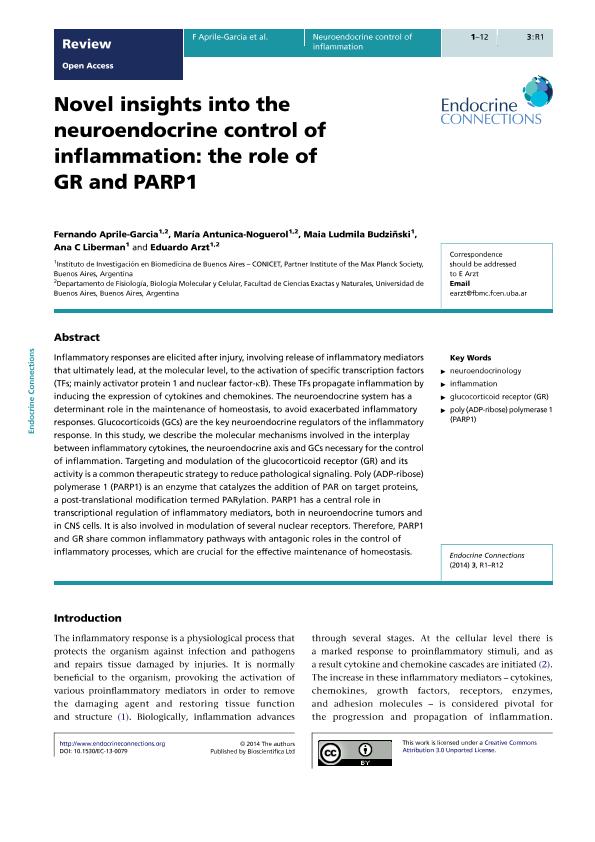Artículo
Novel insights into the neuroendocrine control of inflammation: the role of GR and PARP1
Aprile García, Fernando ; Antunica Noguerol, María de Las Nieves
; Antunica Noguerol, María de Las Nieves ; Budziñski, Maia Ludmila; Liberman, Ana Clara
; Budziñski, Maia Ludmila; Liberman, Ana Clara ; Arzt, Eduardo Simon
; Arzt, Eduardo Simon
 ; Antunica Noguerol, María de Las Nieves
; Antunica Noguerol, María de Las Nieves ; Budziñski, Maia Ludmila; Liberman, Ana Clara
; Budziñski, Maia Ludmila; Liberman, Ana Clara ; Arzt, Eduardo Simon
; Arzt, Eduardo Simon
Fecha de publicación:
12/2013
Editorial:
BioScientifica Ltd
Revista:
Endocrine Connections
ISSN:
2049-3614
Idioma:
Inglés
Tipo de recurso:
Artículo publicado
Clasificación temática:
Resumen
Inflammatory responses are elicited after injury, involving release of inflammatory mediators that ultimately lead, at the molecular level, to the activation of specific transcription factors (TFs; mainly activator protein 1 and nuclear factor-kB). These TFs propagate inflammation by inducing the expression of cytokines and chemokines. The neuroendocrine system has a determinant role in the maintenance of homeostasis, to avoid exacerbated inflammatory responses. Glucocorticoids (GCs) are the key neuroendocrine regulators of the inflammatory response. In this study, we describe the molecular mechanisms involved in the interplay between inflammatory cytokines, the neuroendocrine axis and GCs necessary for the control of inflammation. Targeting and modulation of the glucocorticoid receptor (GR) and its activity is a common therapeutic strategy to reduce pathological signaling. Poly (ADP-ribose)polymerase 1 (PARP1) is an enzyme that catalyzes the addition of PAR on target proteins,a post-translational modification termed PARylation. PARP1 has a central role in transcriptional regulation of inflammatory mediators, both in neuroendocrine tumors and in CNS cells. It is also involved in modulation of several nuclear receptors. Therefore, PARP1 and GR share common inflammatory pathways with antagonic roles in the control of inflammatory processes, which are crucial for the effective maintenance of homeostasis.
Archivos asociados
Licencia
Identificadores
Colecciones
Articulos(IBIOBA - MPSP)
Articulos de INST. D/INV.EN BIOMED.DE BS AS-CONICET-INST. PARTNER SOCIEDAD MAX PLANCK
Articulos de INST. D/INV.EN BIOMED.DE BS AS-CONICET-INST. PARTNER SOCIEDAD MAX PLANCK
Citación
Aprile García, Fernando; Antunica Noguerol, María de Las Nieves; Budziñski, Maia Ludmila; Liberman, Ana Clara; Arzt, Eduardo Simon; Novel insights into the neuroendocrine control of inflammation: the role of GR and PARP1; BioScientifica Ltd; Endocrine Connections; 1; 12-2013; 1-12
Compartir
Altmétricas



